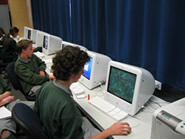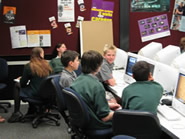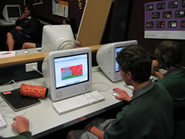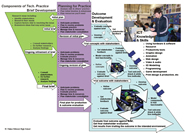Getting the balance right between ICT skills/knowledge and Technological Practice

The cluster identified a key factor for a successful technology course was placing a high value on ICT skills and knowledge. It is critical that enough time is allowed in a programme to develop sufficient skills to ensure students can develop high quality ICT outcomes. While the cluster agreed that good Technological Practice when applied to both ICT teaching and learning resulted in better ICT practice, it was important that the valuing of ICT skills and knowledge was at the core of the teaching programme. Future teaching programmes needed to strike the right balance.
Cluster members took a close look at how they allocated their teaching time and effort. Programmes at both schools were restructured to ensure that Technological Practice was embedded into the process of developing the outcome and became an essential means to producing high quality outcomes. The need for ICT skills and knowledge accrual was to spring naturally from the programme structure. All Unit Standards were therefore tied into a large-scale outcome, and students could see their relevance and necessity. In Year 13, in consultation with teachers, students decided on the Unit Standards and Achievement Standards specifically required for their individual desired outcome.
The cluster identified clear progression pathways for ICT skills and knowledge from junior through to senior schools. Hillcrest's progression from Years 9-13 is in three streams – Programming, Applications and Unit Study. Katikati's pathway plan is similar. Core skills are progressed and built on term-by-term at junior levels – see the Year 10 Case Study BP628: A junior ICT programme – through to NCEA levels 1, 2 and 3, with gradually broadening to more individual needs-based learning at Year 13 within core skill areas.
Components of Technological Practice
To ensure a consistent understanding of good Technological Practice and the thorough embedding of it into the schools' teaching programmes, the cluster looked to the Components of Practice to use as a framework for unit planning, teaching and assessment. Jenny helped take the lead in this, as she had already applied the Components of Practice framework to her teaching planning and practice.
As part of her work on this, Jenny had developed The Diagram, a chart to help students understand and embrace the idea, concepts and application of good Technological Practice. "It makes it clear to students why they are doing various things," says Jenny. "You weren't 'planning', for example, just because the teacher said so, but because it naturally led from your brief into your project. In the past, students spent forever writing briefs and writing plans and by the time they got to do some work they'd lost enthusiasm. Now it's very clear that it's all one process." The document is so integral to students' work that Jenny appends it to all the main handouts for her classes. See Case Study BP629: ICT Programming.
At Katikati, the Components of Practice have been introduced into the junior programmes as a framework for teaching and assessment and to plan progression. The intention is to embed the Components of Practice into all teaching programmes within the Technology faculty. "This is at a very early stage," says Malcolm. "At present, we don't attempt to have all three Components of Practice assessed in every project, as different projects have different balances of Components. But at least having it in place helps get consistency across a range of teachers."
To help achieve this large-scale focus, project-based work was introduced earlier in the year than previously. At Katikati, the senior programmes shifted from two major projects a year to one. At Hillcrest, Jenny still had her senior students do three projects a year, but ensured that the two, smaller, modules lead into one larger one. "This way the students have an idea of the whole process before they do their major project," says Jenny. "Doing the Unit Standards at the beginning of the year gives them confidence." This enables the students to think about their major project right from the start of the year, says Jenny.
Professional support
To help achieve their goals in this area, the cluster received support from Beacon Practice Professional Support FacilitatorsHugh Derham and Cliff Harwood. Hugh's role was mainly to advise on ICT related matters including content and resourcing. He guided the group towards being more creative in their teaching practice and creating opportunities for students to be more creative in their work, and he helped the group find alternative ways of collecting evidence of student practice.
"Hugh's input was invaluable," says Jenny. "He stimulated our thinking and showed us ways to embed good Technological Practice into our programmes of work without losing the excitement and creativity of ICT. He encouraged us to experiment with different teaching, learning and assessment techniques, and have fun again!"
Cliff's role was to ensure teaching and learning reflected best practice in technology education. The cluster says that having input from both Cliff and Hugh was critical to achieving a the right balance: "We didn't want to go too far one way or another and end up with a really good technology education programme that was a bit weak on IT or the other way around, strong on IT but weak in tech ed."
Classroom outcomes in 2006
As is evidenced in Case Studies BP628, BP629 and BP630, the cluster has been highly successful in ensuring that good Technological Practice underpins ICT skill development, knowledge accrual and high quality outcomes.

For their Year 10 ICT class (Case Study BP628: A junior ICT programme), Malcolm and Steve successfully designed a course that would introduce students to the philosophy and skills of Technological Practice and encourage them to go on to study technology/ICT at a senior level. Using their established units as a foundation and a framework, they refined them to serve as a base for the senior level in ICT and Technological Practice skills/ knowledge.
At this level the specific aspects of Technological Practice and ICT skill development were more individually defined. "Just as we teach blocks of skills, so we teach blocks of Technological Practice. Handouts to teach the Components of Practice were developed over a three-year period. Originally it was one handout telling them about all three components, now we use three separate handouts using language we have tried to pitch at the Year 10 level."
The year was structured into four one-term modules. Each unit of work had a clearly defined set of learning outcomes. The focus of each unit was on: developing progression in one of the three components of Technological Practice; developing progression in the ICT domain knowledge and skills needed for Year 11; and developing a broad literacy of ICT issues. The overall aim of the course was to equip students with a combination of ICT and Technological Practice skills and knowledge that would allow them to move into the Achievement Standards-based senior programmes with confidence.
Jenny's Year 11 ICT class (Case Study BP629: ICT Programming) comprised one big project with three modules. Technological practice was embedded in all three modules, with the major project structured around the Components of Practice diagram. In the first module, students created a cover for their Technology portfolio to express their place in today's technological society, for which they learnt basic principles and practices of graphic design including scanning, drawing, painting, and photographing and compositing an image. In the second they were introduced to the Visual Basic programming language and worked through a series of exercises. This was followed by a two-week unit standard task where they applied their skills to planning and designing a simple program.
"In these modules, the Technological Practice was naturally embedded into the development process students followed," says Jenny. "It wasn't made an issue of. It was just: 'this is the way we do things'."
For their major project, students applied these skills and knowledge in developing a computer program to meet a specific learning need – a "real problem for a real-life situation" with the aim to satisfy the needs of stakeholders and a client. This involved identifying, learning and using whatever software application was appropriate to their particular need. Achievement Standards naturally accrued over the course of the project and assessment criteria was picked out as appropriate.

In his Year 12 class (Case Study BP630: Multimedia CD-ROMs), Malcolm had students working on one larger project for the year, rather than two as in the past, to allow more time for teaching skills and developing high quality outcomes, and ensuring that a solid framework of good Technological Practice was in place.
Students were challenged to develop a multimedia solution to an identified issue on a CD-ROM with some combination of text, images, audio, video, animation and 3D modelling. term 1 was spent on skill development and the opportunity to do related unit standards, with the rest of the year focussed specifically on the project.


